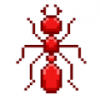A while back, I written a complete guide for keeping Tetramorium sp.e colonies with the materials he had and pleometrophic founding in mind. This is what I had to say about pleometrophic founding :
Explanation: In the wild, ants of this species will sometimes undergo pleometrophic founding, which is when multiple queens work together to found a colony and build a shelter, allowing to produce more workers and brood early on, guaranteeing their survival. However, once a certain number of workers eclose (when pupae transform into adult workers), aggression between queens resumes and the workers slowly kill all of the queens until only the healthiest and fertile remains. In some cases, fight between workers and queens can become so violent, the that workers and queens can unintentionally become injured or killed in the conflict and even in the death of ALL queens. Queens of this species require more food than their worker counterparts which makes them a detriment to the colony when kept in large numbers (In the wild, keeping all the queens alive would result in the whole entire colony starving to death.). This is why a majority of the queens had to be released back into the wild (they may be accepted by other wild colonies or in the most likely scenario, serve them as food, better guaranteeing the survival of their young. It may seem a little cruel, but it is important to remember that processes such as this one are integral to maintaining balance and happen around us all the time, whether we know about it or not.
-
Place the queens (approx. 6-11) in test tube setup and then place the test tube setup in a refrigerator for approx. 5 minutes (this will slow down their metabolic functions, putting them into a deep sleep. once immobilized, make sure they are in contact with one another, allowing them to exchange colony identification pheromones, preventing them from fighting upon waking up. Watch closely for aggressive behavior upon “waking” the queens (If they begin to fight, place them in the fridge again. If they continue fighting after being introduced to the fridge a maximum of 3 times, call me for assistance.).
-
Once calm and placed into the test tube setup, place the test tube in a dark location such as a closet, drawer or shoe box and check them periodically once or twice every week. If one of the queens dies prematurely due to a bacterial infection or being unfertilized, remove her with tweezers. If the queens become aggressive, place them in the fridge for five minutes and call me for further help.
-
-
Once you have reached the 45-50 worker mark, buy a mini hearth (brown paint , white sand , side mounting foraging area).
-
Remove foraging area from nest and plug entrance with a cork.
-
Dump as many ants into the foraging area as possible and put the foraging are in the fridge. Once put into a deep sleep, collect all but 3-4 queens (the healthiest) and release the rest outside. You may then take any remaining workers in the test tube setup and dump them into the foraging area (dampen the end of a barbecue skewer and carefully use the tip to collect any remaining brood items in the test tube setup and carefully place them in the outworld.
A while back, I written a complete guide for keeping Tetramorium sp.e colonies with the materials he had and pleometrophic founding in mind. This is what I had to say about pleometrophic founding :
Explanation: In the wild, ants of this species will sometimes undergo pleometrophic founding, which is when multiple queens work together to found a colony and build a shelter, allowing to produce more workers and brood early on, guaranteeing their survival. However, once a certain number of workers eclose (when pupae transform into adult workers), aggression between queens resumes and the workers slowly kill all of the queens until only the healthiest and fertile remains. In some cases, fight between workers and queens can become so violent, the that workers and queens can unintentionally become injured or killed in the conflict and even in the death of ALL queens. Queens of this species require more food than their worker counterparts which makes them a detriment to the colony when kept in large numbers (In the wild, keeping all the queens alive would result in the whole entire colony starving to death.). This is why a majority of the queens had to be released back into the wild (they may be accepted by other wild colonies or in the most likely scenario, serve them as food, better guaranteeing the survival of their young. It may seem a little cruel, but it is important to remember that processes such as this one are integral to maintaining balance and happen around us all the time, whether we know about it or not.
Edited by ctantkeeper, February 24 2017 - 9:54 AM.














